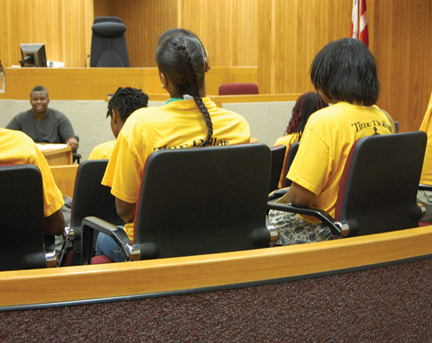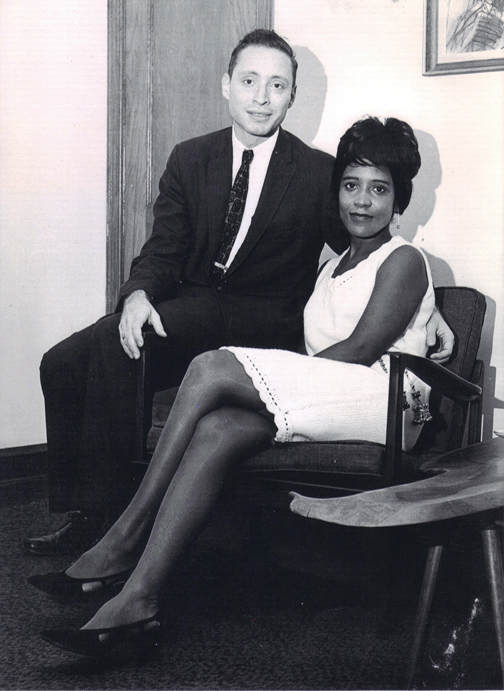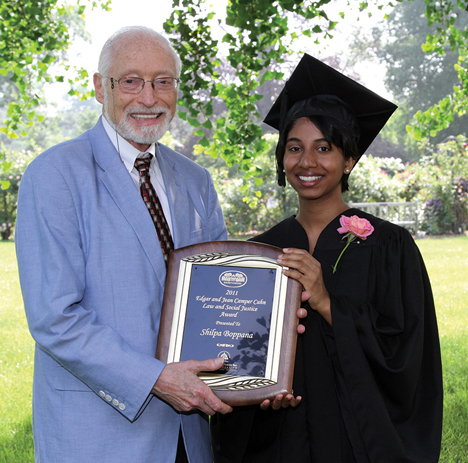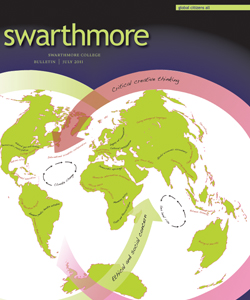Juvenile Injustice
For nearly half a century, Edgar Cahn ’56 has been brainstorming ways to bring about fair treatment of minorities. Now he’s working on an innovative approach to keeping kids from being incarcerated.
 IT WAS 1996 WHEN CIVIL RIGHTS CRUSADER AND ATTORNEY EDGAR CAHN convinced District of Columbia Supreme Court Judge Eugene Hamilton to approve new juvenile justice courts in the city. Describing the district’s juvenile justice system as “a direct pipeline feeding youth into the adult prison system,” Cahn presented the court with the following statistics—numbers that told a disturbing truth about juvenile justice throughout the United States:
IT WAS 1996 WHEN CIVIL RIGHTS CRUSADER AND ATTORNEY EDGAR CAHN convinced District of Columbia Supreme Court Judge Eugene Hamilton to approve new juvenile justice courts in the city. Describing the district’s juvenile justice system as “a direct pipeline feeding youth into the adult prison system,” Cahn presented the court with the following statistics—numbers that told a disturbing truth about juvenile justice throughout the United States:
- Twenty-five percent of children in the District of Columbia were white, but 100 percent of the children who were in detention were youth of color.
- Between 40 and 50 percent of youth of color didn’t graduate from high school.
- Fifty-four percent of 18-to-35-year-old African American males in DC were either in prison, on probation, or out on bail awaiting trial.
Cahn had asked the DC Supreme Court to try a novel approach to juvenile justice. The court sanctioned the Time Dollar Youth Court (TDYC), a diversion program that has turned out to be a fairer and more productive way to address infractions by youth, especially young men of color. According to its website, the TDYC “enlists young people in creating a new kind of juvenile justice where youth juries have the power to impose a sentence on offenders and where nonviolent youth can avoid formal prosecution for their offenses by carrying out the sentence imposed by their peers.” The offender pays a “fine” that is measured in time spent on community service—and one frequent sentence is to serve on a TDYC jury.
The term “time dollar” refers to the method of exchange in TimeBanks, one of Edgar Cahn’s much earlier innovations for social change. Time dollars, quite simply, are a bankable promise to do something for someone else in a community in exchange for that person or group of persons doing something for you. The goal is to strengthen communities through reciprocity. “TimeBanking turns strangers into friends,” Cahn says, “weaving community one hour at a time as time dollars are earned and spent. It has evolved into a service credit program with TimeBanks in 34 countries on six continents, including 200 in the United States and 120 in Great Britain.” Cahn’s time-banking movement, which was created in 1980, has provided a perfect foundation for the youth courts he envisioned in the 1990s.
In 2008, the TDYC heard 912 cases for offenses such as simple assault, possession with intent to distribute marijuana, and disorderly conduct. During the 12 months following a referral to the youth court, the recidivism rate was below 10 percent—far less than the 33 to 35 percent rate of a comparison group that was processed by a detention-biased juvenile system.
IN A 2010 ARTICLE IN THE University of the District of Columbia Law Review, Cahn and co-author Cynthia Robbins, former executive director and president of the Maya Angelou Public Charter School in DC, an institution that includes a school for young men in district prisons, decried the effects of early incarceration. “Too often, youth of color get locked up; their development is suspended much like the fossilized insect frozen in petrified amber—stuck,” they wrote.This causes “many long-term injurious consequences that amount to anything but rehabilitation.”
The proven success of youth courts and other youth advocacy programs in reducing pretrial detention—and arresting the spiraling consequences of incarceration—has Cahn and others wondering why just a handful of jurisdictions have adopted such programs. In the face of a 2006 Department of Justice report stating that 38 percent of the 96,655 juveniles incarcerated in the United States were African American when just 16 percent of American youth are black, Cahn and Robbins proposed—and have begun to implement—a novel legal strategy to change the juvenile justice system nationwide: the Racial Justice Initiative (RJI).
“With this strategy, we are doing two things,” Cahn said during a conversation on campus last fall. “We’re taking on the onerous burden of proving that officials have intended the resulting injury [to youth of color], and we’re asking judges and other government officials why they continue to use methods that are more expensive and don’t work as well.”
The law appears to be on his side. Despite federal juvenile justice legislation in 1992 and 2002 that explicitly mandated a reduction in disproportionate minority contact (DMC) by law enforcement, Cahn says that the systemic government practices that lead to DMC persist. In addition, Cahn says, because court decisions such as Washington v. Davis (1976) require injured parties to prove discriminatory intent before claiming harm, individual plaintiffs—most often young men of color—have been left with the burden of proving that past actions resulted from intentional discrimination. Few if any such cases have been successful, and the RJI has taken on that burden, says Cahn.
THE INNOVATIVE KEY TO THE RJI is another Supreme Court case—the 1989 City of Canton v. Harris decision that holds municipal governments accountable for “deliberate indifference” that causes harm—even if that indifference was expressed through doing nothing. Cahn and Robbins seek to apply the “indifference” test in a new context: the enforcement of equal-protection rights, such as when “the juvenile justice system continues to subject youth of color to the high risks of injury from decisions regarding detention and confinement that manifest a racial bias.” It’s where intent meets liability—when decision-makers are made aware of more effective and less injurious alternatives (such as diversion programs) yet maintain a pattern of practices that violate constitutional rights.
Edgar Cahn’s life has been a model for such actions and a testament to his deep concern for the rights, welfare, and dignity of the disenfranchised. His father, Edmond Cahn, an attorney and philosopher with deep family ties to old New Orleans, left that city for New York in 1928 because he disapproved of segregation. He raised Edgar to believe that human beings have the innate capacity to recognize and respond to injustices.
“It was drilled into me,” Cahn said, “that we were here to create a more just world and that segregation and racism was, in some sense, the quintessential injustice. I was brought up believing that all people were equal.”
So entrenched were these beliefs, Cahn didn’t begin to understand the depths of racism until he arrived at Swarthmore in 1952. “As a concept, yes, I knew it was a bad thing,” said Cahn, “but I was naïve….” So naïve, in fact, that he couldn’t have imagined the uproar that would occur on campus when he began courting Jean Camper ’57, an African-American first-year student born into a family of social activists, during his sophomore year at the College—or the turmoil his subsequent engagement to Jean would bring to their families and their lives.
“When Dean of Men Everett Hunt asked what I was trying to do [by dating a black woman], I replied, ‘She is a human being whom I love.’ But when he said, ‘If you are going to agitate, you have to expect problems,’ I began to understand how pervasively racism affects us.”

After the uproar that Edgar Cahn ’56 and Jean Camper ’57 encountered when they became engaged, the couple spent 34 years of marriage—until Camper’s death in 1991—working together within the legal system to make a difference for the disenfranchised.
The couple married in 1957, after Jean had graduated from Swarthmore and Edgar had completed his first year of graduate school at Yale. She joined him at Yale, and in 1963, law degrees in hand, Edgar and Jean began law careers in Washington, D.C., working together within the legal system to make a difference for the disenfranchised.
Working with U.S. Attorney General Robert Kennedy and later with Sargent Shriver, the first director of the Office of Economic Opportunity, Edgar and Jean created the National Legal Services program during the War on Poverty. Their article “The War on Poverty: A Civilian Perspective” (Yale Law Journal, 1964) provided the blueprint for the organization; Shriver later credited the article with being the “genesis of legal services.” In 1971, the Cahns founded the Antioch School of Law—predecessor to the University of the District of Columbia David A. Clarke School of Law (UDC-DCSL)—the first U.S. law school to educate law students primarily through clinical training in legal services to the poor.
SO IT'S NOT SURPRISING THAT CAHN WAS STILL BRAINSTORMING ways to bring about justice for minorities in 2008, when he hit upon the RJI. Yet to establish that policymakers were guilty of “deliberate indifference,” a plaintiff would have to prove that law enforcement officials and juvenile court judges actually knew about alternatives to secure detention such as the youth courts. To do this, Cahn and Robbins devised a “public notice process” that made sure that such information was available to policymakers. By disseminating knowledge about effective alternatives to current injurious and discriminatory practices, they seek to give public officials notice of more efficient and economical ways to achieve better outcomes for minority youth—and for society at large. Then, Cahn says, if those officials still choose to use past ineffective methods, their actions will demonstrate their indifference, i.e. their intent to discriminate.
With a grant from the W.K. Kellogg Foundation, Cahn and Robbins (who describes herself as “Edgar’s colleague in arms for civil rights,”) began laying the groundwork for giving public notice. Their UDC-DCSL Law Review article “An Offer They Can’t Refuse: Racial Disparity in Juvenile Justice and Deliberate Indifference Meet Alternatives That Work” set the stage for implementation of the strategy. The article, says Cahn, establishes “the incontrovertible evidence that race bias affects critical decisions leading to detention or confinement and its devastating effects on juveniles of color … and proposes a system-change strategy that envisions the use of litigation as the last step and a last resort.”
In the July/August 2010 issue of the Clearinghouse Review Journal of Poverty Law and Policy, Cahn and Robbins, joined by Keri Nash, associate for legal research and outreach at RJI, explained how public notice forums create awareness of intolerable racial disparities in the juvenile justice system by giving “official decision makers formal notice both of the pattern of entrenched racial disparity that results from current practices and of less costly, more effective alternatives…. We contend that, once the officials receive this notice, if they continue present practice rather than adopting alternatives, they make an intentional choice that reflects deliberate indifference to the fundamental constitutional rights of youth of color in the juvenile system and to the injuries to their rights.”
The first public notice forum, focusing on successful alternatives to incarceration, took place in May 2010 in Harrisburg, Pa. “We selected Pennsylvania for several reasons,” Cahn says in the Clearinghouse article—“long-standing connections to state legislators, Pennsylvania’s reputation as a flagship state in using detention alternatives to lower disproportionate minority contact, and the presence in the state of nationally recognized juvenile justice leaders. And, we knew that there was a resource in Pennsylvania—successfully operating youth courts [including one in Chester, Pa.]—that could mean the difference between success and failure during the forum.”
Cahn asked public interest attorney Greg Volz, founder of the first school-based youth court in Chester, to support his strategy, proposing that Chester youth testify before the Pennsylvania legislature. Volz, whose goal is to provide Chester students with a constructive alternative to suspension and reduce disciplinary issues, has been so effective in motivating and redirecting students that the city now has five in-school youth courts.

The first Edgar and Jean Camper Cahn Law and Social Justice Award was presented to Shilpa Boppana ’11 during Commencement weekend. The award, sponsored by the College and the Pennsylvania Bar Association, celebrates Boppana’s commitment—and that of the award’s namesakes—to social justice. A Chester Fellow, Boppana founded the Chester Youth Court Volunteers on campus during her junior year.
Swarthmore students, sponsored by the Lang Center for Civic and Social Responsibility, have assisted Volz in creating the additional youth courts. Shilpa Boppana ’11, who founded the Chester Youth Court Volunteers on campus, helped develop a youth court handbook and lesson plans for new members.
Brian Foster and Jamar Saunders, both 18 and founding members of the Chester High School Youth Court, prepared to testify in Harrisburg—shaping their statements and learning presentation skills under the guidance of Kimberly St. Julian ’12. Wearing jackets and ties, the two young men spoke of youth court’s impact on them—from giving them positive friendships and leadership roles in their community to encouraging them to attend college. “Youth court means a lot to me, [because] I want to be able to give students a second chance like I was given a second chance,” Foster said. Saunders added: “Youth court became something that I could own, because I put so much of my time and effort into making it work.”
“The young men testified so effectively,” Volz says, “they changed the opinion of people in Pennsylvania government about what is possible.
TODAY, CAHN'S STRATEGY IS MAKING HEADWAY. Lawmakers and government officials have begun to recognize the difference—both economically and socially—that offering alternative solutions can make. A 2008 study by the Hamilton Fish Institute on School and Community Violence at George Washington University found that 75 percent of all young people referred to more than 1,255 youth courts nationwide complete their sentences within one year. In December, the executive director of the Pennsylvania House committee on children and youth contacted Volz, asking how to set up youth courts statewide. Meanwhile, Volz says, “We are studying 25 states that have youth court legislation so we can have a bill in the Pennsylvania legislature this year.”
According to Robbins, “What keeps Edgar going is his commitment to justice and a belief that our democracy can produce better outcomes.”
Cahn, now 76, takes the long view. “I won’t live to see all the differences,” he says, “but I hope I have set a process in motion. I know the National Legal Services program helped a million households in the mid-1990s. When Jean and I started clinical education with the Antioch School of Law, we were viewed as anti-intellectual, and yet, recently, I attended a national conference for clinical law professors and virtually every law school in the country now provides clinical education. TimeBanking is still barely just a drop in the ocean, but recently I spent time with a woman who negotiated with the Agency for International Development to bring TimeBanking into Senegal and, now, the women of that country are learning marketable skills they can use as currency.
“But my greatest asset has been my ignorance,” says Cahn. “I went ahead and did what people said couldn’t be done.”
 Email This Page
Email This Page